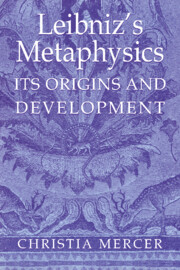Book contents
- Frontmatter
- Contents
- Acknowledgments
- References to Leibniz's works
- Introduction: first truths and half truths
- PART ONE METAPHYSICS OF METHOD
- PART TWO METAPHYSICS OF SUBSTANCE
- 2 Aristotelian assumptions, 1668–69
- 3 Original conception of substance, 1669
- 4 Second conception of substance, 1669–early 1671
- PART THREE METAPHYSICS OF DIVINITY
- PART FOUR METAPHYSICS
- Appendix I (Not exactly) First truths
- Appendix II Leibniz's original assumptions
- Bibliography
- Index Locorum
- Index
3 - Original conception of substance, 1669
from PART TWO - METAPHYSICS OF SUBSTANCE
Published online by Cambridge University Press: 12 March 2010
- Frontmatter
- Contents
- Acknowledgments
- References to Leibniz's works
- Introduction: first truths and half truths
- PART ONE METAPHYSICS OF METHOD
- PART TWO METAPHYSICS OF SUBSTANCE
- 2 Aristotelian assumptions, 1668–69
- 3 Original conception of substance, 1669
- 4 Second conception of substance, 1669–early 1671
- PART THREE METAPHYSICS OF DIVINITY
- PART FOUR METAPHYSICS
- Appendix I (Not exactly) First truths
- Appendix II Leibniz's original assumptions
- Bibliography
- Index Locorum
- Index
Summary
In April 1669, Leibniz wrote a letter to Jakob Thomasius in which he argues at length for the reconciliation of the Aristotelian and the mechanical philosophies and for a conception of substance that would effect that reconciliation. In the same year, he prepared an edition of a text by the sixteenth-century humanist, Mario Nizolio, which he published in early 1670. Leibniz wrote a lengthy introduction to Nizolio's book, On the True Principles and the True Method of Philosophizing, Against the Pseudo-Philosophers, of 1553. Both Nizolio's text and Leibniz's introduction discuss the proper way of philosophizing. It is significant that Leibniz attached to his introduction a slightly revised version of his April 1669 letter to Thomasius. The letter thereby became the young man's first published text on a contemporary metaphysical topic. Both Leibniz's proposal for reconciliation and his argument for it are strikingly odd. He insists that much of mechanical philosophy follows from Aristotelian principles and that Aristotle's physics is explicable in mechanical terms. His argument includes a reformation of Aristotle's notions of substantial form and matter into a mechanical conception of body. Leibniz happily concludes that by such means the mechanical philosophy “can be reconciled with Aristotle's.”
The apparent perversity of Leibniz's position is due to the fact that nothing could be further from the truth. The philosophies proposed by mechanists like Descartes and Gassendi explicitly reject the foundations of the Aristotelian system.
- Type
- Chapter
- Information
- Leibniz's MetaphysicsIts Origins and Development, pp. 99 - 129Publisher: Cambridge University PressPrint publication year: 2001



